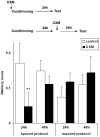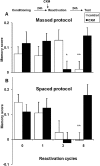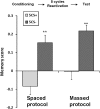A switch from cycloheximide-resistant consolidated memory to cycloheximide-sensitive reconsolidation and extinction in Drosophila
- PMID: 19228975
- PMCID: PMC6666331
- DOI: 10.1523/JNEUROSCI.3789-08.2009
A switch from cycloheximide-resistant consolidated memory to cycloheximide-sensitive reconsolidation and extinction in Drosophila
Abstract
It is generally accepted that, after learning, memories stabilize over time and integrate into long-term memory (LTM) through the process of consolidation, which depends on de novo protein synthesis. Besides, studies on several species have shown that reactivation of already stabilized LTM can either make this memory labile and then restabilize it (a process called reconsolidation) or inhibit it (extinction). However, the identity of both processes and their interactions with consolidation are still under debate. Regarding memory stabilization, Drosophila offers a striking exception since, in this species, LTM is not the sole stable form of memory. Under specific learning conditions, anesthesia-resistant memory (ARM) can be formed through processes yet unknown but that are resistant to cycloheximide, a classical protein synthesis inhibitor that impairs LTM. Here, we took advantage of this dichotomy to ask whether both ARM and LTM could be extinguished and/or reconsolidated. We also studied whether two forms of memory extinction and reconsolidation exist in flies, as for memory stabilization. We show that either reconsolidation or extinction can be induced after olfactory conditioning in Drosophila, depending on the number of reactivations as in other species. Furthermore, regarding the effect of cycloheximide, the ARM/LTM dichotomy for stabilization does not apply to extinction and reconsolidation. Blocking protein synthesis interfered with both processes regardless of whether initial stabilization was sensitive (LTM) or not (ARM) to cycloheximide. These results thus show that Drosophila is a useful model to tackle these questions and that reconsolidation is not necessarily a mere repetition of consolidation.
Figures




Similar articles
-
Acquisition, consolidation, reconsolidation, and extinction of eyelid conditioning responses require de novo protein synthesis.J Neurosci. 2005 Feb 23;25(8):2070-80. doi: 10.1523/JNEUROSCI.4163-04.2005. J Neurosci. 2005. PMID: 15728847 Free PMC article.
-
Memory reconsolidation allows the consolidation of a concomitant weak learning through a synaptic tagging and capture mechanism.Hippocampus. 2013 Oct;23(10):931-41. doi: 10.1002/hipo.22149. Epub 2013 Jul 8. Hippocampus. 2013. PMID: 23733489
-
Spontaneous recovery from extinction depends on the reconsolidation of the acquisition memory in an appetitive learning paradigm in the honeybee (Apis mellifera).J Neurosci. 2005 May 4;25(18):4485-92. doi: 10.1523/JNEUROSCI.0117-05.2005. J Neurosci. 2005. PMID: 15872095 Free PMC article.
-
Reconsolidation and the fate of consolidated memories.Neurotox Res. 2008 Dec;14(4):353-8. doi: 10.1007/BF03033859. Neurotox Res. 2008. PMID: 19073438 Review.
-
Translational Approaches Targeting Reconsolidation.Curr Top Behav Neurosci. 2016;28:197-230. doi: 10.1007/7854_2015_5008. Curr Top Behav Neurosci. 2016. PMID: 27240676 Free PMC article. Review.
Cited by
-
Feeding a rich diet supplemented with the translation inhibitor cycloheximide decreases lifespan and ovary size in Drosophila.Biol Open. 2024 Nov 15;13(11):bio061697. doi: 10.1242/bio.061697. Epub 2024 Nov 25. Biol Open. 2024. PMID: 39588711 Free PMC article.
-
Circuit reorganization in the Drosophila mushroom body calyx accompanies memory consolidation.Cell Rep. 2021 Mar 16;34(11):108871. doi: 10.1016/j.celrep.2021.108871. Cell Rep. 2021. PMID: 33730583 Free PMC article.
-
Memory extinction and spontaneous recovery shaping parasitoid foraging behavior.Behav Ecol. 2021 Jun 30;32(5):952-960. doi: 10.1093/beheco/arab066. eCollection 2021 Sep-Oct. Behav Ecol. 2021. PMID: 34690548 Free PMC article.
-
A systems level approach to temporal expression dynamics in Drosophila reveals clusters of long term memory genes.PLoS Genet. 2017 Oct 30;13(10):e1007054. doi: 10.1371/journal.pgen.1007054. eCollection 2017 Oct. PLoS Genet. 2017. PMID: 29084214 Free PMC article.
-
Conditioned avoidance responses survive contingency degradation in the garden slug, Lehmannia valentiana.Learn Behav. 2014 Dec;42(4):305-12. doi: 10.3758/s13420-014-0147-9. Learn Behav. 2014. PMID: 24946946
References
-
- Alberini CM. Mechanisms of memory stabilization: are consolidation and reconsolidation similar or distinct process? Trends Neurosci. 2005;28:51–56. - PubMed
-
- Dudai Y. Reconsolidation: the advantage of being refocused. Curr Op Neurobiol. 2006;16:174–178. - PubMed
-
- Dudai Y, Eisenberg M. Rites of passage of the engram: reconsolidation and the lingering consolidation hypothesis. Neuron. 2004;44:93–100. - PubMed
-
- Dudai Y, Morris R. To consolidate or not to consolidate: what are the questions? In: Bolhius J, editor. Brain, perception, memory. Advances in cognitive sciences. Oxford: Oxford UP; 2000. pp. 149–162.
Publication types
MeSH terms
Substances
LinkOut - more resources
Full Text Sources
Medical
Molecular Biology Databases
